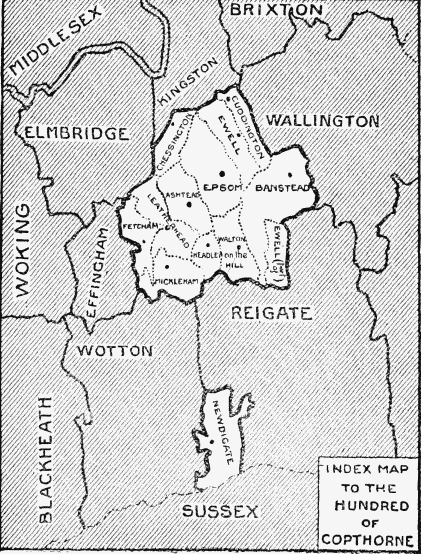A History of the County of Surrey: Volume 3. Originally published by Victoria County History, London, 1911.
This free content was digitised by double rekeying. All rights reserved.
'The hundred of Copthorne: Introduction and map', in A History of the County of Surrey: Volume 3, ed. H E Malden (London, 1911), British History Online https://prod.british-history.ac.uk/vch/surrey/vol3/p246 [accessed 1 February 2025].
'The hundred of Copthorne: Introduction and map', in A History of the County of Surrey: Volume 3. Edited by H E Malden (London, 1911), British History Online, accessed February 1, 2025, https://prod.british-history.ac.uk/vch/surrey/vol3/p246.
"The hundred of Copthorne: Introduction and map". A History of the County of Surrey: Volume 3. Ed. H E Malden (London, 1911), British History Online. Web. 1 February 2025. https://prod.british-history.ac.uk/vch/surrey/vol3/p246.
THE HUNDRED OF COPTHORNE (fn. 1)
CONTAINING THE PARISHES OF
| ASHTEAD | EPSOM | LETHERHEAD |
| BANSTEAD | EWELL | MICKLEHAM |
| CHESSINGTON | FETCHAM | NEWDIGATE (part of) |
| CUDDINGTON | HEADLEY | WALTON ON THE HILL |
This hundred has undergone some change in its area since 1086, (fn. 2) when it included part of Weybridge, the rest being entered under its later hundred of Elmbridge, and also West Betchworth, which is now in Wotton Hundred. 'Mideham,' the identification of which is uncertain, was in Copthorne. (fn. 3) Newdigate is not named in Domesday, and Chessington was included in the hundred of Kingston.
Copthorne was a royal hundred, and remained in the hands of the Crown, though leased for 21 years to Thomas Jenkins in 1617. (fn. 4) In a subsidy roll of the 14th century it was said to be worth £47 15s. 6¼d., and with Effingham Hundred it was assessed for ship - money at £136 16s. 4d. in 1636. (fn. 5)

INDEX MAP TO THE HUNDRED OF COPTHORNE
The honour of Wallingford extended into the hundred at Chessington, (fn. 6) and in 1300 the Earl of Cornwall was said to have 4s. from a view taken here at Easter, and pertaining to the honour. (fn. 7) The Abbot and convent of Chertsey (fn. 8) had view of frankpledge in Horton in Epsom, and Robert Darcy received a similar grant from Edward III for his lands in Letherhead. (fn. 9) John D'Abernon had view of frankpledge at Fetcham in 1279, (fn. 10) and in the same year presentment was made that his father William D'Abernon had withdrawn his suit at the hundred court for land in Headley. (fn. 11) The grant in 1547 to John Rychbill of the land of the Abbot of Boxley in Chessington included view of frankpledge. (fn. 12)
